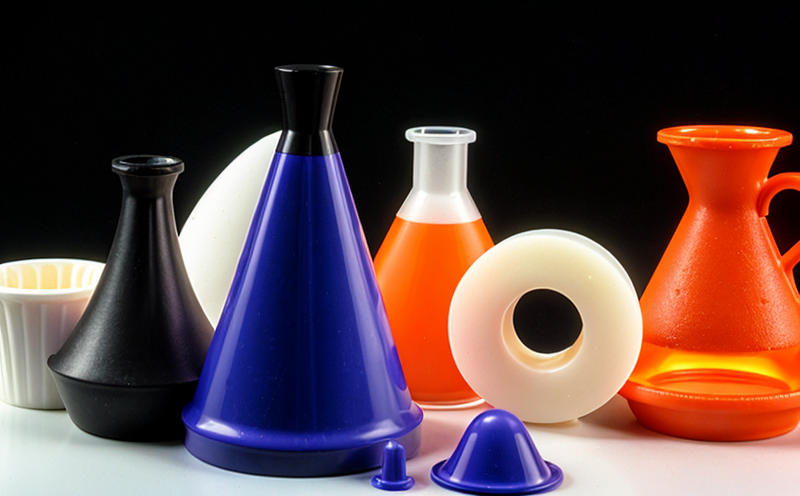AOAC 999 Additive Residue Testing in Polymers
The AOAC International Standard Method 999 is a widely recognized protocol for analyzing additive residues in polymers. This method ensures that the levels of additives used in polymer formulations comply with regulatory requirements and safety standards.
Polymers are essential components in various industries, including automotive, electronics, and consumer goods. The use of additives enhances their performance by providing properties such as flexibility, durability, or resistance to heat and chemicals. However, the presence of excessive or incorrect additives can pose health risks and environmental concerns.
The AOAC 999 method involves several steps that are designed to detect and quantify additive residues in polymers. The process begins with sample preparation, where the polymer is ground into a fine powder for consistent analysis. This step ensures accurate results by allowing the extraction of additives from the matrix.
Following sample preparation, the extracted additives undergo a series of purification steps to separate them from other components. Chromatographic techniques are commonly used in this stage to achieve high purity and ensure reliable quantification. The purified extracts are then analyzed using spectrophotometric methods or gas chromatography-mass spectrometry (GC-MS), depending on the specific additive being tested.
The AOAC 999 method is particularly useful for identifying trace amounts of additives that might not be visible through other means. This capability makes it invaluable in quality control and compliance verification processes. Compliance officers rely on this testing to ensure their products meet regulatory standards, while R&D engineers use the results to optimize polymer formulations.
Quality managers also benefit from AOAC 999 testing by gaining insights into potential issues that could affect product performance or safety. By detecting even small amounts of unwanted additives, they can take corrective actions early in the production cycle, reducing waste and improving overall product quality.
The method's precision and accuracy are further enhanced by its strict adherence to international standards such as ISO 17025 for laboratory accreditation. This ensures that results are consistent across different laboratories and meet global quality requirements.
For procurement teams, AOAC 999 testing provides valuable information about the reliability of suppliers' raw materials. By ensuring that additives do not exceed specified limits, they can maintain high standards in their supply chain management practices.
- Competitive Advantage: Ensures compliance with international regulations, enhancing brand reputation and market competitiveness.
- Informed Decision-Making: Provides data-driven insights into additive usage patterns within polymer formulations.
- Risk Mitigation: Early detection of non-compliant additives helps prevent potential legal issues and recalls.
Why It Matters
The importance of AOAC 999 testing in polymer additive residue analysis cannot be overstated. Regulatory bodies worldwide, such as the U.S. Food and Drug Administration (FDA) and European Union regulations, mandate compliance with these standards to ensure public health and environmental safety.
Non-compliance can lead to severe consequences, including product recalls, legal actions, and damage to brand reputation. Therefore, quality managers and compliance officers must prioritize AOAC 999 testing as part of their quality assurance programs. This proactive approach not only protects consumers but also safeguards the company's long-term interests.
R&D engineers can leverage AOAC 999 test results to innovate safer polymer formulations that meet stringent regulatory requirements. By continuously monitoring additive residues, they can stay ahead of industry trends and develop products that are both safe and efficient.
For procurement teams, ensuring compliance with AOAC 999 standards helps build trust with suppliers and ensures the reliability of raw materials used in production. This commitment to quality enhances overall supply chain resilience and fosters better relationships with partners.
In summary, AOAC 999 testing is crucial for maintaining high standards in polymer additive use, thereby contributing to safer products and more sustainable business practices.
Eurolab Advantages
At Eurolab, we pride ourselves on delivering comprehensive and reliable AOAC 999 testing services. Our team of experienced professionals ensures that every aspect of the process—from sample preparation to final analysis—is conducted with precision and care.
We utilize state-of-the-art equipment and methodologies that adhere strictly to international standards, guaranteeing accurate results. Our laboratory is ISO 17025 accredited, ensuring credibility and reliability in all our findings.
Our clients benefit from our expertise not only in performing AOAC 999 tests but also in interpreting the data accurately. This knowledge allows them to make informed decisions regarding their polymer additive usage and compliance strategies.
We offer flexible service packages tailored to meet the unique needs of each client, whether it be regular testing or one-off assessments. Our dedicated customer support team is always available to assist with any inquiries or concerns you may have about our services.
Competitive Advantage and Market Impact
- Premium Service Quality: Delivering accurate, consistent results that exceed industry expectations.
- Regulatory Compliance: Ensuring all tests meet the latest regulatory standards, enhancing market access.
- Innovation Support: Providing valuable insights to R&D teams for developing safer and more efficient products.
- Risk Reduction: Identifying potential issues early on through proactive testing, minimizing risks associated with non-compliance.
- Sustainable Practices: Contributing to the development of sustainable polymer formulations that meet environmental standards.





